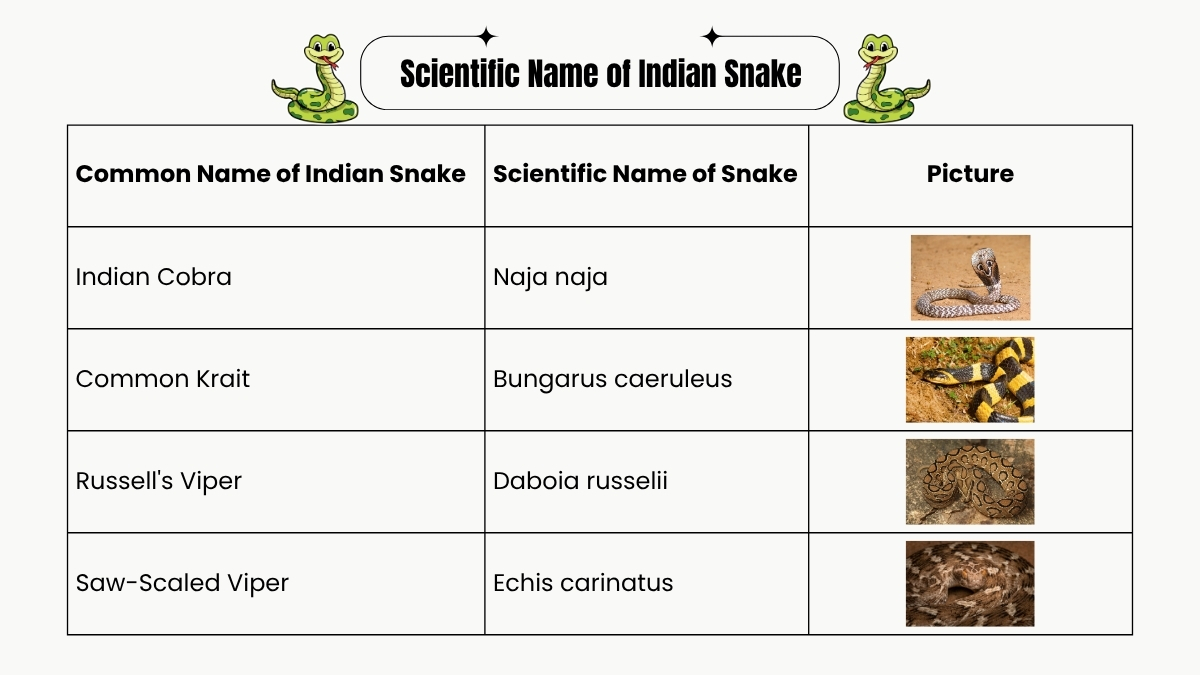Scientific name of a snake: Snakes are some of the most interesting and, in many places, most scary animals on Earth. In India, where between 46,000 and 60,000 people die from snakebites every year (Mongabay-India), knowing how to classify snakes is not just academic; it is important for public health.
In February 2024, Karnataka, India, declared snakebite envenoming a notifiable disease because it recognized the need for better data. This caused the number of reported cases to rise sharply, from 6,596 in 2023 to 13,235 in 2024, according to reports.
Let's look at the main scientific name for snakes and the larger snake classification that includes these amazing reptiles.
What is the Scientific Name of Snake?
Serpentes is the most common scientific name for snakes. This name is technically the suborder of the Order Squamata, which is the order that includes lizards. The term Serpentes is derived from the Latin word 'serpō', meaning "to creep or crawl." This suborder comprises all limbless, elongated, carnivorous reptiles that people commonly refer to as snakes, totaling over 3,600 recognized snake species worldwide.
Snake Scientific Name in India
India is home to over 300 snake species, 66 of which are venomous and a serious health threat. The four most dangerous species, collectively known as the "Big Four," are responsible for most snakebite cases in the country. Knowing the precise snake’s scientific name in India is essential for antivenom production and treatment.
| Common Name of Indian Snake | Genus and Species (Scientific Name) | Family |
| Indian Cobra | Naja naja | Elapidae |
| Common Krait | Bungarus caeruleus | Elapidae |
| Russell's Viper | Daboia russelii | Viperidae |
| Saw-Scaled Viper | Echis carinatus | Viperidae |

The scientific name of the cobra, Naja naja, clearly shows the genus name of snake (Naja) followed by the species name.
Scientific Name of Python Snake
Pythons are part of a family of snakes that don't have venom and are known for being very big. The overall family name is Pythonidae. A great example of a large species is the Indian Python, one of the famous scientific names of the python snake species.
| Common Name of Python Snake | Genus and Species (Scientific Name) | Family |
| Indian Python (or Rock Python) | Python molurus | Pythonidae |
| Burmese Python | Python bivittatus | Pythonidae |
What is the Classification of Snake?
Snakes belong to a clearly defined hierarchy of groups in biology, collectively called snake classification or taxonomy. This system helps scientists understand how snakes are related to other animals, moving from the broadest category (Kingdom) down to the most specific (Species). Here is the general classification of snakes (Suborder Serpentes):
| Taxonomic Rank | Name for Snakes |
| Kingdom | Animalia |
| Phylum | Chordata |
| Class | Reptilia |
| Order | Squamata |
| Suborder | Serpentes (The formal group name for all snakes) |
Snakes share the Order Squamata with lizards, showing their close evolutionary relationship, even though snakes lost their limbs over time.
Also Read - List of Top 11 Colorful Snakes in the World: Updated
What are Scientific Names in Biology?
Scientific names are the unique, two-part Latin or Latinized names given to every recognized organism on Earth, a system known as binomial nomenclature established by Carl Linnaeus. The Genus and Species of the organism are always part of these names. The most important thing about a scientific name is that it works for everyone. This means that it stays the same no matter what language or region you are in, which can be confusing. For instance, a scientist in India and a scientist in Russia can talk about the Python molurus and be sure that they are both talking about the same snake. This standardized naming system is very important for all kinds of global research and conservation work in biology.
Check Out: 5 Mind-Blowingly Rare Orange Snakes that You’ve (Probably) Never Heard of
Serpentes is the scientific name for snakes, and it is the key to understanding how snakes work. Using binomial nomenclature for some species, like Naja naja and Python molurus, makes it easy for scientists and researchers all over the world to talk to each other. As public health efforts improve the collection of data on snakebites, especially in high-risk areas like India, this exact biological identification is still very important for effective treatment and prevention plans.
Comments
All Comments (0)
Join the conversation